Elise Canouse's I-Search project. Posts are ordered from 1-9. Part 1 is tagged "introduction". Part 2 is tagged "research process" Part 3 is tagged "results" Part 4 is tagged "annotated Bibliography.
Don't wanna be here? Send us removal request.
Photo
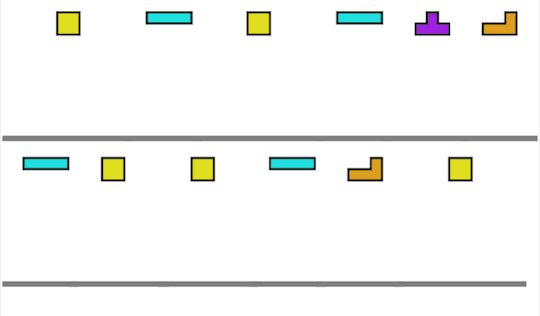
Ah, Tetris. The classic game of falling blocks was released in 1984, inspired by the creators favorite board game: Pentominos [1]. Since then, Tetris has boomed in popularity and notoriety. It is known for being one of the best selling video games of all time (it appears 3rd and 10th in Wikipedia’s ‘List of best-selling video games’, representing just 2 of many different versions of tetris) [3]. There is a Tetris movie coming out next year [4]. Tetris is even considered to be the first video game to ever be played in outer space [5].
On top of all of that, Tetris has been the subject of psychological interest, most notably for giving the catchy moniker for Game Transfer Phenomena (GTP): The Tetris Effect [6].
Link to gif-maker (x).
#post 1#the tetris effect#tetris syndrome#game transfer phenomena#i-search project#introduction#sts1010
1 note
·
View note
Photo

The official Tetris website gives a quick definition for the Tetris Effect, as follows:
“The Tetris® Effect is a catchy term that players use to describe the way they are inspired by the game and see Tetriminos in everyday situations. Because Tetris, like the real world, challenges players to make order out of chaos using a specific organization system, the game components translate easily into lifestyle interpretations. Whether you're packing the trunk of your car, loading a dishwasher, or organizing your shelves, you're likely thinking about how each object will fit together strategically with minimal empty space. This is the Tetris Effect!” [1].
Coming into this assignment, that is pretty close to my understanding of the Tetris Effect. I personally have experienced it before, mostly with other games. I remember after playing Pokemon Ruby (my first introduction to the Pokemon world) for too long, I would have trouble walking in diagonals. I felt like I could only go forwards, backwards, left, or right to get anywhere that I needed to go, just like my character in the game. Of course, once I snapped out of it just a bit, I could walk in any direction. But this didn’t change that my brain felt so certain that there were only four valid directions.
In my I-Search project, I want to explore deeper into the Tetris Effect: What are the implications of the effect? Why are we so prone to it? What are other common variations that people experience? What is going on neurologically when we experience this?
While I don’t exactly expect to find nice and neat answers for all of these questions, I will be using them to guide my research.
#post 2#the tetris effect#tetris syndrome#game transfer phenomena#i-search project#introduction#sts1010
0 notes
Photo
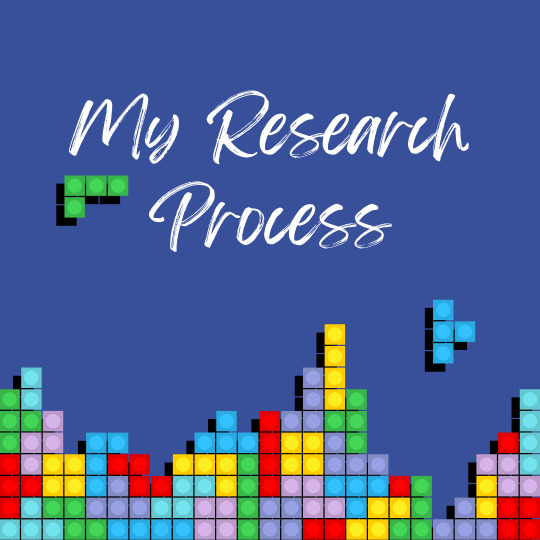
To begin my research for this project, I used two particular ‘jumping off’ points. This included the official Tetris website, which has pages describing the history of the game and answering frequently asked questions about the game, and Wikipedia’s page for “Tetris Effect”. I personally love to use Wikipedia to begin my research. It always helps me to develop a foundation of knowledge for understanding what I am researching, and it contains a treasure trove of resources at the very bottom of the page in the ‘References’ section. Once I got the ball rolling, I was slightly overwhelmed with the amount of information there was. Simply reading the Wikipedia article loaded me with so many facts and concepts that I wanted to look into.
It was pretty easy for me to find resources that I believe to be credible. However, I did include some sources that I consider to be pseudo-credible; for example, I wouldn’t necessarily trust Wikipedia or the Guinness World Records for in depth research, but I was comfortable with citing them for anecdotal information.
I think that it was fairly easy for me to find credible information on this topic due to the fact that my topic has a unique name that refers to a specific scientific phenomenon. I did run into some minor issues at first due to the fact that a video game by the name “Tetris Effect” was released in 2018, so that clogged up a lot of my early search results [7]. Once I found that it was also known as ‘Tetris Syndrome’ and the more formal name ‘Game Transfer Phenomena’, it was much easier to find credible information.
The single most helpful source that I found in my research was an entire website about Game Transfer Phenomena that was run by a researcher who has spent the last decade researching the topic, Dr. Angelica B. Ortiz de Gortari. This website contains blogs and research papers and resources and gamer testimonies all surrounding GTP. Many sources that I ended up using were either from this site or linked on this site.
#post 3#the tetris effect#tetris syndrome#game transfer phenomena#i-search project#research process#sts1010
0 notes
Photo
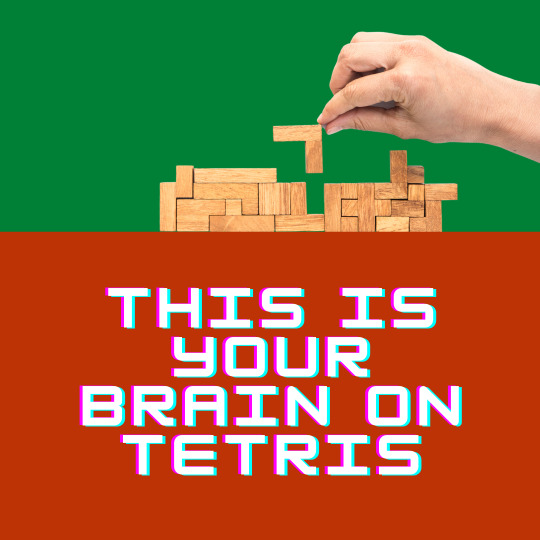
The term “Tetris Effect” was coined by Jeffrey Goldsmith in his 1994 article called “This Is Your Brain on Tetris”. However, he was talking about something a little bit different. His use of the phrase referred to the biochemical processes that occur in the brain while playing Tetris.
Specifically, his article discusses the idea that playing “Tetris significantly raises cerebral glucose metabolic rates (GMRs), meaning brain energy consumption soars” [12]. Your brain then begins to crave the feeling of heightened GMRs, which contributes to the addictive nature of Tetris. Once you become better and better at the game, however, you think less and less about each move, which means that your GMR doesn’t shoot up like it used to. Goldsmith refers to this process as the Tetris Effect.
2 years later, the term picked back up in an article by Garth Kidd. Kidd describes the Tetris Effect in the way that it is understood today: “Many people, after playing Tetris for more than an hour straight, report being plagued by after-images of the game for up to days afterwards, an ability to play the game in their head, and a tendency to identify everything in the world as being made of four squares and attempt to determine ‘where it fits in’” [13]. He goes on to give examples from other relevant video games at the time, including Descent and Civilization.
0 notes
Audio
Listen to Elise with special guest Jordan discuss Tetris Syndrome!
Link to Podcast (x).
Transcript under the cut
Elise: Hello, hello and welcome back to Mind Games! Before we get started, I’d like to talk about our sponsor for today’s episode, Goop! Check out their revolutionary Ear Seed Kit! Use tweezers to place small 24-karat gold plated ‘seeds’ in your ear! They are self-adhesive, and you should leave them on for 3-5 days! We’re not asking how they are both self-adhesive and gold-plated, and neither should you! Elevate your wellness with Goop for only $45 dollars!
I have with me today special guest Jordan, a Sleep Psychologist with the Tiger Paw Institute! How are you doing Jordan?
Jordan: I’m doing just swell today Elise. Thank you for having me, I’m very excited!
Elise: Of course! We are very excited to have you!
Elise: Now, today we will be talking about a study from October of 2000 regarding The Tetris Effect. The name of the study is “Replaying the Game: Hypnagogic Images in Normals and Amnesics”. This study really helped me to understand just how ingrained into our minds this Tetris Syndrome is. So let’s jump right in!
Jordan: I’m very excited to hear about this today, Elise.
Elise: So, to conduct this study, the researchers had 27 participants: 12 Tetris novices with no prior experience, 10 Tetris experts, and 5 “amnesics with extensive, bilateral medial temporal lobe damage” [10]. They were all asked to play a total of 7 hours of Tetris over the course of 3 days, and then reported if they thought about playing the game as well as whether they experienced ‘Hypnagogic Images’.
Jordan: So I’m glad that you brought up Hypnagogic Images, because this is something that I’ve studied pretty extensively. So, the word hypnagogia refers to the state between wakefulness and sleep [11], and many people experience what we call hypnagogic illusions. These can affect any of your senses. So, for example, have you ever been drifting off to sleep and suddenly feel like you’re falling?
Elise: Oh, definitely.
Jordan: Right, so that’s an example of a hypnagogic hallucination.
Elise: Interesting! So in this particular study, they were focused on the particular aspect of Game Transfer Phenomena that occurs during hypnagogia and affects the visual sense. Ultimately, there were 38 reports of participants experiencing the hypnagogic images specifically related to Tetris.
Jordan: Wow, that’s a lot!
Elise: Right? Only over three days!
Jordan: Right.
Elise: So, the participants would see stuff like Tetris pieces, and sometimes they would be falling. Some of them even reported that the lines would disappear, just like they were playing the game [10]. Now, here’s the really interesting part of the results: None of the amnesic participants could remember, from one session to the next, that they had played Tetris, or that they had even met the experimenter. However, 3 out of the 5 participants reported experiencing Tetris-related hypnagogic imagery.
Jordan: That’s such a high rate!
Elise: Right? They even reported this experience at a higher rate than the Tetris experts [10]. Isn’t that wild?
Jordan: That is wild. So in your research, what does it appear that the implications of these findings are?
Elise: Well, the biggest implication that we get from this particular study is that now we know that it is unlikely that, for at least this aspect of Tetris syndrome, that it is caused by the structures in your brain that are associated with declarative memory. Instead, the researchers theorize that it is more similar to your body developing muscle memory, which is on the subconscious side of memory [10].
Jordan: Wow. That’s really incredible. I can’t wait to see how this fits into my research of sleep.
Elise: All right, well, this is where our discussion of this particular study ends, but I’d be really curious to see this replicated. Reading this study has really opened my eyes to the possibilities of Game Transfer Phenomena.
Jordan: I absolutely agree!
Elise: Well, thank you for coming and sharing your expertise with us today, Jordan! You’ve been a real pleasure to have!
Jordan: Before we go, I have to ask you: What do you call a snoozing dinosaur?
Elise: What do you call a snoozing dinosaur?
Jordan: A dino- SNORE!
Elise: Very nice! Thank you to all of our listeners for tuning in today, come back next week for more Mind Games!
0 notes
Photo
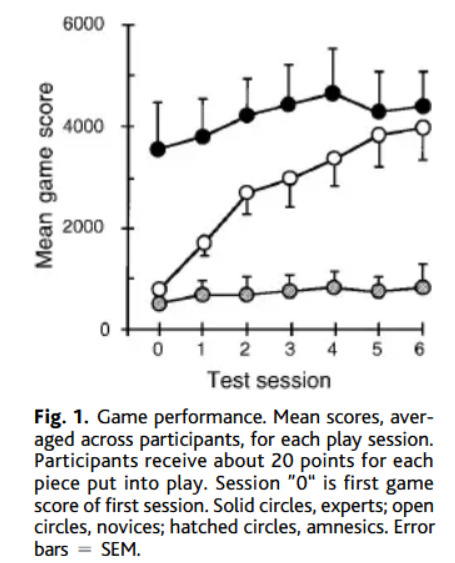
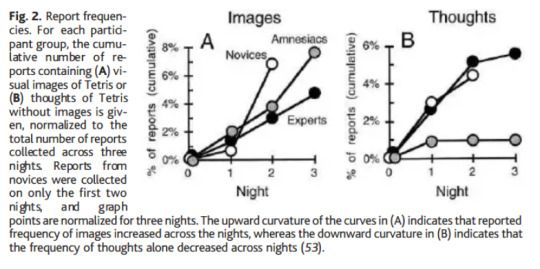
These graphs show some of the results discussed in this week’s episode of Mind Games!
Source: [11]
0 notes
Photo
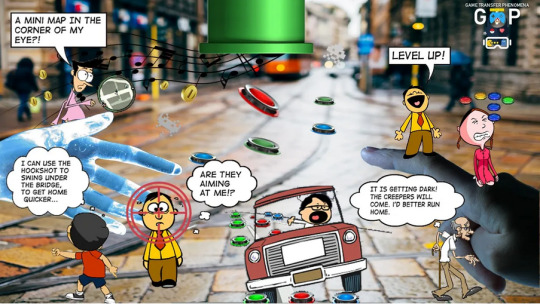
When discussing the Tetris Effect in a more formal way, we turn to the study of Game Transfer Phenomena. The term was coined by Dr. Angelica B. Ortiz de Gortari in a 2010 study that involved interviewing frequent gamers. She defines it on her website as follows: “Game Transfer Phenomena (GTP) comprise sensory perceptions, spontaneous mental processes and behaviours derived from interactions with digital simulations in a video game environment” [9].
Here are some facts about GTP that she discusses:
There is no significant difference in GTP between different genders found in most studies.
Players on the younger side (i.e., between 15 and 22) are more prone to experience GTP. They are also more likely to experience more varied forms of GTP.
Players tend to view GTP as a positive experience.
While most players have not reported negative effects, some have indicated that GTP causes trouble sleeping.
Image source (x).
0 notes
Photo

Although Game Transfer Phenomena specifically discusses the after effects of playing video games, we can expand the scope of the Tetris Effect way beyond this. Many give the example of people seeing curved shapes after playing jigsaw puzzles, or speedcubers seeing algorithms after solving rubik’s cubes [15].
Some psychologists go even so far as to include completely different effects, such as having a song stuck in your head or getting ‘sea legs’ after being on a ship for an extended period of time [14]. These psychologists claim that The Tetris Effect refers to any experience that leaves an ‘after image’ on your brain.
0 notes
Photo

My annotated bibliography is included under the cut. While I have 15 sources, many of them are only cited in the introduction or research process portions of my project.
For this project, I decided to number the sources and use the number in brackets as my in-text citations. I used this method because I had several sources that would’ve been difficult to differentiate otherwise considering that they shared an author.
[1] About Tetris®. Tetris. (n.d.). Retrieved December 5, 2021, from https://tetris.com/about-us.
This is the official “About Us” page for Tetris. I would not consider this particularly credible for research purposes, but it is good for anecdotal purposes. This is referenced in my introduction as opposed to my research results.
[2] History of Tetris®. Tetris. (n.d.). Retrieved December 5, 2021, from https://tetris.com/history-of-tetris.
This is the official “History of Tetris” page for Tetris. I would not consider this particularly credible for research purposes, but it is good for anecdotal purposes. This is not referenced in my project, but I did use it to build foundational knowledge.
[3] Wikimedia Foundation. (2021, December 2). List of best-selling video games. Wikipedia. Retrieved December 5, 2021, from https://en.wikipedia.org/wiki/List_of_best-selling_video_games.
This is a list of best selling video games from Wikipedia. I would not consider this particularly credible for research purposes, but it is good for anecdotal purposes. This is referenced in my introduction as opposed to my research results. I could not find a similar list in a location that I found to be more credible.
[4] Cameron, E. (2021, November 8). Cameras roll as Hollywood Movie Tetris starts filming in Aberdeen. Press and Journal. Retrieved December 5, 2021, from https://www.pressandjournal.co.uk/fp/news/aberdeen-aberdeenshire/3604407/tetris-aberdeen-filming/.
This article discusses the upcoming Tetris movie. I would not consider this particularly credible for research purposes, but it is good for anecdotal purposes. This is referenced in my introduction as opposed to my research results.
[5] First person to play a videogame in Space. Guinness World Records. (n.d.). Retrieved December 5, 2021, from https://www.guinnessworldrecords.com/world-records/109300-first-person-to-play-a-videogame-in-space.
This is the Guinness World Record for first person to play a videogame in space. I would not consider this particularly credible for research purposes, but it is good for anecdotal purposes. This is referenced in my introduction as opposed to my research results.
[6] Dr Angelica Ortiz de Gortari. (2018, December 19). Embracing pseudo-hallucinatory phenomena induced by playing video games: Game transfer phenomena. Game Transfer Phenomena | Targeting the real life impact of virtual interactions. Retrieved December 6, 2021, from https://gametransferphenomena.com/2018/11/embracing-pseudo-hallucinatory-phenomena-induced-by-playing-video-games/.
This is an article from the website gametransferphenomena.com, where Dr. Angelica Ortiz de Gortari discusses her work. I found this entire site to be credible after looking into Dr. Ortiz de Gortari’s credentials. She not only coined the term “Game Transfer Phenomena”, she also appears to be the leading expert in the subject.
[7] TETRIS® EFFECT. (2021, October 7). News: Tetris® effect. TETRIS® EFFECT: CONNECTED. Retrieved December 6, 2021, from https://www.tetriseffect.game/news/.
This is the news page from the website for Tetris Effect, the video game. I would not consider this particularly credible for research purposes, but it is good for anecdotal purposes. This is referenced in my research process as opposed to my research results.
[8] Ortiz de Gortari, A. B. (2020, January 8). The Game Transfer Phenomena universe. Game Transfer Phenomena | Targeting the real life impact of virtual interactions. Retrieved December 6, 2021, from https://gametransferphenomena.com/.
This is the homepage from the website gametransferphenomena.com, where Dr. Angelica Ortiz de Gortari discusses her work. I found this entire site to be credible after looking into Dr. Ortiz de Gortari’s credentials. She not only coined the term “Game Transfer Phenomena”, she also appears to be the leading expert in the subject.
[9] Ortiz de Gortari, A. (2021, April 26). What is game transfer phenomena: Game transfer phenomena. Game Transfer Phenomena | Targeting the real life impact of virtual interactions. Retrieved December 6, 2021, from https://gametransferphenomena.com/the-impact-of-video-games/.
This is an article from the website gametransferphenomena.com, where Dr. Angelica Ortiz de Gortari discusses her work. I found this entire site to be credible after looking into Dr. Ortiz de Gortari’s credentials. This article was very relevant to my research because it described GTP in layman’s terms and listed a broad variety of information in one place.
[10] Stickgold, R., Malia, A., Maguire, D., Roddenberry, D., & O'Connor, M. (2000, October 13). Replaying the game: Hypnagogic images in normals and amnesics. Science. Retrieved December 6, 2021, from https://www.science.org/doi/10.1126/science.290.5490.350.
This is a study that appeared to be published in several scientific journals, which cemented it’s credibility. This study helped me to conceptualize the impact of the Tetris Effect and helped me to understand how it worked in the brain. This study is the subject of my podcast portion.
[11] What are waking dreams? Sleep Foundation. (2021, June 25). Retrieved December 7, 2021, from https://www.sleepfoundation.org/how-sleep-works/hypnagogic-hallucinations.
This is an article that helped me to understand what Stickgold and Ortiz de Gortari meant when they talked about hypnagogic hallucinations. The Sleep Foundation appears to be a reputable non-profit that employs many accredited psychologists.
[12] Goldsmith, J. (1994, May 1). This is your brain on Tetris. Wired. Retrieved December 6, 2021, from https://www.wired.com/1994/05/tetris-2/.
This article contains the original mention of the phrase “Tetris Effect”. I was unable to find any mention of the phrase prior to 1994, and many other articles refer to this as the origin. This was a credible source for my research into the history of the Tetris Effect.
[13] Kidd, G. (1996, February 20). The risks digest, volume 17 issue 78. The Risks Digest. Retrieved December 7, 2021, from http://catless.ncl.ac.uk/Risks/17.78.html#subj1.
This article contains the first mention of the phrase “Tetris Effect” as a reference to Tetris Syndrome that I discuss in my project. This was a credible source for my research into the history of the Tetris Effect.
[14] Yogi, P. (2021, February 28). The tetris effect: Psych yogi. Psych Yogi | A Wealth of Free Psychology! Retrieved December 7, 2021, from http://psychyogi.org/the-tetris-effect/.
This video and transcript helped shape my research by delving into what are examples of Tetris Syndrome that are unrelated to videogames and games in general. I found that the website is run by a psychologist, so it is credible in the capacity that I referenced it. I.e., it is credible to say that some psychologists are of the opinion that is explored in the video.
[15] The Tetris effect (definition + examples). Practical Psychology. (2021, November 16). Retrieved December 7, 2021, from https://practicalpie.com/the-tetris-effect/.
This article discussed other variations of Tetris Syndrome, specifically in regard to non-video games. While the article was not written by a psychologist, it did reference credible sources and I found the information in the article corroborated across various sources.
#post 9#the tetris effect#tetris syndrome#game transfer phenomena#i-search project#annotated bibliography#sts1010
1 note
·
View note